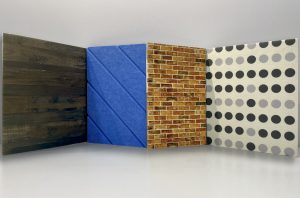Sound insulation is an essential consideration for both homes and public spaces. Whether you’re a homeowner seeking a quieter living environment, an acoustic engineer working on a project, or a DIY enthusiast looking for the best materials for your next task, understanding how different materials contribute to soundproofing is important.

Importance of Sound Insulation
Effective sound insulation can significantly enhance the quality of life by reducing unwanted noise and creating more comfortable and peaceful environments. In public spaces, it ensures privacy and enhances concentration, while in homes, it helps maintain tranquillity and improves sleep quality.
As urban areas become noisier, the demand for effective materials for soundproofing continues to rise.
Common Sound Insulation Materials
There are several materials commonly used for sound insulation, each offering distinct advantages depending on the application. Here’s a quick overview:
- Fibreglass
- Mass-Loaded Vinyl (MLV)
- Acoustic Foam Panels
- Mineral Wool
- Soundproofing Paint
- Cork
Detailed Breakdown of Each Material
1. Fibreglass
Effectiveness: Fibreglass is a popular choice for soundproofing due to its excellent absorption properties. It’s particularly effective at blocking high-frequency sounds.
Cost: Relatively affordable, making it accessible for most homeowners and DIY projects.
Installation: Usually installed within walls, ceilings, and floors. It requires a framework to hold the fibreglass batts in place.
2. Mass-Loaded Vinyl (MLV)
Effectiveness: MLV offers superior sound-blocking capabilities. Its dense structure helps reduce noise transmission across walls and floors.
Cost: Moderately priced, but the benefits often outweigh the costs for those requiring advanced soundproofing.
Installation: Can be nailed or screwed onto walls and floors. Also available as a roll, making it easier to cut to size.
3. Acoustic Foam Panels
Effectiveness: Primarily used for absorbing sound rather than blocking it, these soundproofing panels are great for reducing echo and improving room acoustics.
Cost: Generally affordable and available in various shapes and sizes.
Installation: Easy to install with adhesive backing or mounting strips, suitable for walls and ceilings.
4. Mineral Wool
Effectiveness: Like fibreglass, mineral wool offers excellent sound absorption and is also fire-resistant, adding an extra layer of safety.
Cost: Slightly more expensive than fibreglass but offers additional benefits.
Installation: Similar to fibreglass, installed within walls, ceilings, and floors.
5. Soundproofing Paint
Effectiveness: While not as effective as other materials at blocking sound, soundproofing paint can help reduce noise levels when used as an additional measure.
Cost: Budget-friendly, though multiple layers may be required for noticeable results.
Installation: Easy to apply using a brush or roller, just like regular paint.
6. Cork
Effectiveness: Cork is an excellent natural sound absorber, ideal for reducing impact noise from floors.
Cost: Moderately priced, with sustainable and eco-friendly properties adding value.
Installation: This can be installed as underlayment beneath flooring or as wall tiles.
Tips for Choosing the Right Material
- Consider Your Needs: Identify whether you need to block or absorb sound. Different materials offer varying levels of effectiveness for each.
- Budget: Determine your budget and find materials that offer the best balance between cost and performance.
- Installation Requirements: Consider the ease of installation and whether you’ll need professional help.
Future Trends in Sound Insulation
Advancements in technology are leading to new and improved sound insulation materials.
Innovations such as smart sound-absorbing panels and eco-friendly insulation options are becoming increasingly popular. These trends indicate a future where soundproofing solutions are more efficient, sustainable, and integrated into everyday building practices.
Conclusion
Sound insulation is a vital aspect of creating comfortable living and working environments. Understanding the properties and applications of different materials, you can make informed decisions to achieve optimal soundproofing. Whether you’re a homeowner, an acoustic engineer, or a DIY enthusiast, the right choice of materials can make a significant difference.

**mindvault**
mindvault is a premium cognitive support formula created for adults 45+. It’s thoughtfully designed to help maintain clear thinking